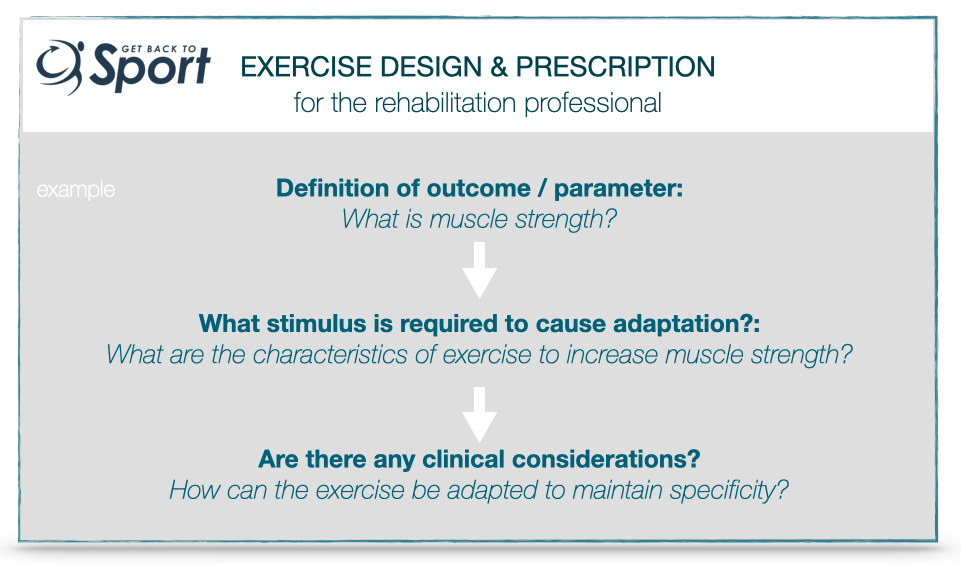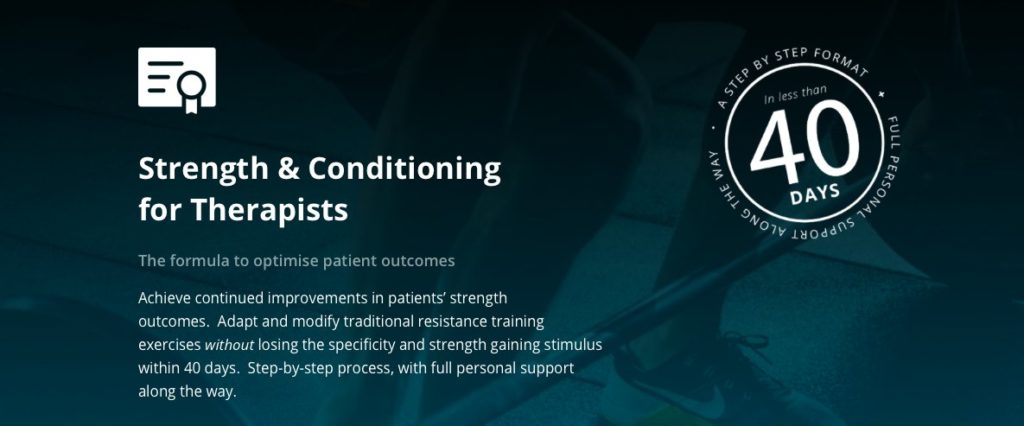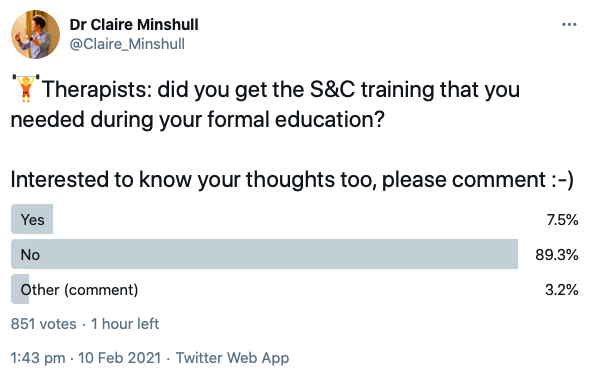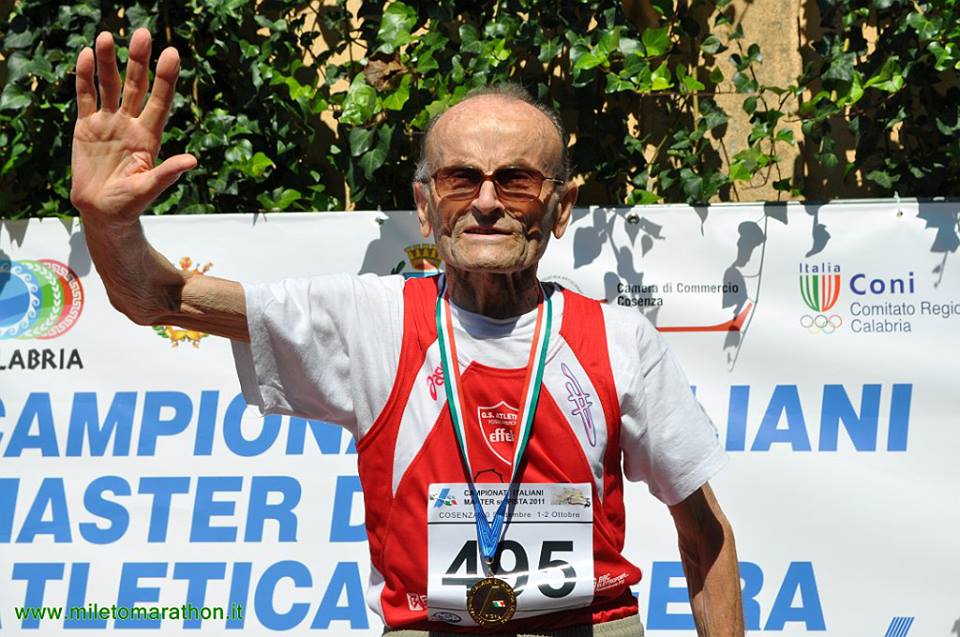Welcome to post 58 of Strength & Conditioning For Therapists. I hope you’ve been enjoying the recent posts on adjuncts to rehab. Today and in line with the upcoming enrolment to the online S&C For Therapists course we’re going to go a little philosophical and explore whether or not strength & conditioning is needed in therapists’ training? Did you get the strength & conditioning you needed?
Did you get the Strength & Conditioning Training you Needed?
Are you a physiotherapist, physical therapist, osteopath, chiropractor, sports therapist, athletic trainer? Actually what I’m really asking here is do you rehabilitate patients, athletes, clients? Are you involved in restoring function and return to activities, whether that be with athletes or the general public?
I’m guessing your answer is yes here if you’re reading this blog.
My second question is then, did you study strength and conditioning, or even the principles of exercise prescription during your formal education?
My prediction here is no, or not to the level that you need it. How do I know? Well, I’ve had the privilege of teaching Strength & Conditioning to 100s (probably 1000s now actually) of Therapists over the past 3 years. By far the majority state that they didn’t receive even remotely enough training on S&C and exercise prescription during their education.
To add to this, yesterday I did a poll on Twitter – yes, not the most scientific of enquiries, but very informative nevertheless (thank you for your responses too), the result was the same. Take a look:
Nearly 90% of 851 people stated No, they didn’t receive the S&C training that they needed. Comments highlighted a massive disparity between programmes, from 1 lecture on the topic of exercise prescription to a full module in the better programmes. Invariably though the comments highlighted the lack of provision and how therapists sought these skills and knowledge separately.
Are we / am I making too big a deal of this?
Strength and conditioning has become a bit of a buzz term in rehab and therapy over recent years. This has prompted people to question whether it’s a fad, or if it’s a way forward. In fact I discussed this with Nick Grantham and Andrew McCauley on The Physio Matters Podcast recently. I get that there’s always a ‘new’ or ‘next best thing’ and many of these can be of no utility to rehab.
Whilst I do think that there are aspects strength & conditioning and exercise science that have utility in rehabilitation, I definitely don’t think we need to train therapists into becoming S&C coaches (unless of course they want to). Given that recovery, rehabilitation and return to activity in many cases is reliant on the adaptations caused by appropriately dosed physical exercise, however, it would seem pertinent to teach therapists about exercise, adaptation, dose and definitions. Did you get the the strength & conditioning training you needed?
So let’s have a little look at some of the basic principles.
Definitions
What is the outcome that you really want to improve? Can you drill down and understand its component parts? Do you clearly understand what these are?
A simple example: through your assessments you determine that your patient is weak and they need to get stronger. What is muscle strength?
Once you have a clear definition of what you’re working towards, you can then determine what you need to do to improve this outcome – to promote adaptation. This might sound simple, but can you succinctly describe the difference between muscle strength and muscle power and then the physiological determinants?
Principles of Training
I’ve spoken about this so many times before; in my view it’s the key component of any successful strength & conditioning programme or exercise prescription. As a reminder these principles are:
- SPECIFICITY
- OVERLOAD
- PROGRESSION
Specificity in our example above is muscle strength; let’s be pedantic here and say maximal muscle strength:
the maximal force a muscle / muscle group can produce in a single contraction
The overload, or stimulus therefore needs to be aligned with the desired outcome. What do the rehabilitation exercises need to look like in order to optimally improve muscle strength? Generally high force, few reps, plenty of inter-set rest, but that’s another post.
Get the top two principles right and your patient/client will progress. Yay! BUT, we need to build this into our prescriptions to avoid stagnation. Generic exercise sheets and non-individualised prescriptions are unlikely to give you the best chance of achieving this.
We could also talk about dose here.
What is Exercise Dose?
Dose is:
a measured amount of something such as medicine
Cambridge English Dictionary
In terms of exercise or rehabilitation, dose here might mean how much exercise per session, per week, per programme.
Do you know what the optimal dose is for improvement of muscle strength? How much how often etc.?
Dose can also refer to the intensity of exercise, and of course the intensity of any given exercise will decrease as a person becomes fitter/stronger/more powerful.
As stated above, we need to take account of this progression in our rehabilitation programming, else people will plateau in their improvements.
S&C Training is Different with Patients, Right?
Okay, so when you’re dealing with patients and clients who are in pain, have clinical restrictions, ROM difficulties you may feel that these principles cannot apply. How, for example, can you improve muscle strength in a limb with an externally limited ROM, or if loading through range provokes discomfort?
Coming from a place of care and not wanting to cause pain, the temptation might be to reduce the load of the strength exercise, despite the clinical need to improve it. I get that, of course I do. But unfortunately in reducing load you’ve reduced the effectiveness of the exercise.
This is where clinicians and rehabilitation professionals have a really tough deal – and might I add – where even Strength & Conditioning qualifications don’t really help. You need to think creatively using your S&C and exercise prescription knowledge to change the parameters of the exercise to maintain specificity. How can you adapt the exercise to keep the high load but make it tolerable/clinically advocated?
Strength & Conditioning For Therapists
This might seem like a lot to take in if this is a new topic to you, or maybe you’re violently nodding your head if you adhere to these principles already.
It doesn’t have to be overwhelming and you don’t need an S&C qualification to improve – really improve – the effectiveness of the exercises you prescribe. It just requires a little thought up front and a top-up of knowledge on the aspects of S&C the are applicable to your practice.
Here’s the thought process and flow of exercise prescription using the strength example above.

Strength & Conditioning For Therapists
If you’re keen to learn more about this topic and how to implement the critical components of S&C into your practice, check out our flagship course.

Strength & Conditioning For Therapists isn’t just a training programme, but an implementation programme. You’ll have a step-by-step formula to integrate the essential strength and conditioning principles into your rehabilitation practice -plus heaps more. Click the button below to get all the information – and get on the priority notification list. Enrolment opens soon!




